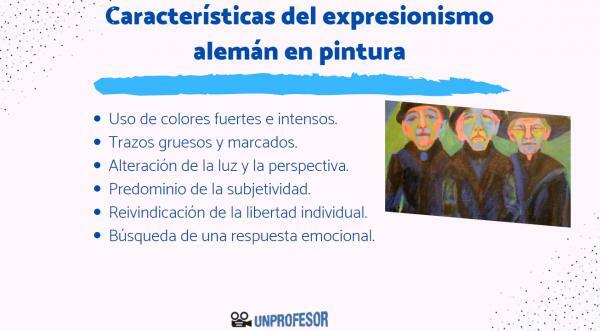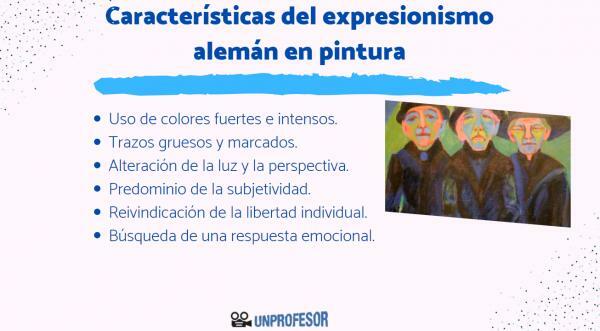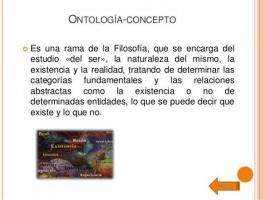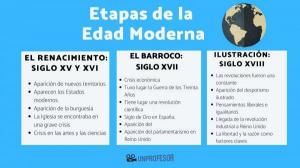Characteristics of German EXPRESSIONISM in painting

The expressionism responds to a reaction to hedonism and the constant search for the objective beauty of impressionists, giving way to a more subjective impression in which the artist expresses his emotions and feelings. Is avant-garde artistic trend It emerged in Germany at the beginning of the 20th century, between 1905 and 1910, having the city of Munich as its origin.
A more personal art as a result of the disenchantment generated among German artists and intellectuals in the years after the Franco-Prussian War. This pessimism and subjectivism also made a dent in the painters, showing in their works everything morbid, obscene, forbidden, fantastic and supernatural.
In this lesson from a TEACHER we offer you a summary of the main characteristics of German expressionism in painting.
General characteristics of expressionist painting.
Expressionism is part of the artistic vanguards of the 20. Between the main characteristics of German expressionism in painting we highlight:
Use of strong and intense colors
The dark and intense colors were one of the tools used to create distressing and unreal environments.
Thick and marked lines
Expressionist painting is characterized by the use of strong, aggressive, thick and angular lines, without adding precision to the forms, rather distorting them. It is about fleeing from objectivity when reproducing an object or subject, presenting reality according to your own perception and feelings. Pointed shapes, diagonals, oblique lines and impossible angles dominate the space to generate impossible atmospheres.
Alteration of light and perspective
Light and perspective are also secondary. It is not about reproducing an accurate image of reality, so the light and perspective are intentionally altered depending on the general tone of the painting. Thus, shadows and contrasts are used trying to create dark, oppressive, dramatic and disturbing spaces.
Predominance of subjectivity
Painters let their feelings flow through their paintings, opting for themes that reflect intense feelings and emotions, revealing loneliness, misery, fear, old age, sadness, etc., and scenes in which you flee from all complacency esthetic. Pessimism, existential anguish and anxiety became the protagonists of many works.
Claiming individual freedom
For the expressionists, subjectivity and irrationality are evidences of the individual freedom of the artist, allowing him to go beyond the limitations of the rational world.
Search for an emotional response
Another characteristic of German expressionism in painting is that it sought an emotional response in the viewer through the deliberate and exaggerated distortion of the subjects.

Image: Slideshare
Characteristics of expressionist painting in stages.
Let's get to know the characteristics of German expressionism differentiating them by stages, since, depending on the moment in which we meet, there were some trends or others.
1. Influences and precursors
Among the influences from which the Expressionist painters drank, that of the post-impressionistsVincent Van Gogh and Paul Gaugin, painters who made the expressiveness of color and the gesture of the line their hallmarks, and that of the Symbolists Edvard munch and the Belgian James Ensor, pioneers in showing more grotesque, cartoonish and emotional aspects in their paintings.
The search for expressiveness also led to inspiration from African and Oceanian sculptures and masks.
1905-1913: Die Brücke (The Bridge)
The first act of expressionism is dated 1905 and it came from the hand of a group of young artists who wanted to escape from the conventions and build a bridge towards the art of the future. Thus, a group of artists led by the painter Ernst Ludwig Kirchner founded Die Brücke (The Bridge) in the city of Dresden. In this first stage, and to print anguish and subjectivity, the expressionist painters subordinated the use of color and technique to grotesque and marginal themes, showing inclination towards primitivism.
In addition to Kirchner, we also find Erich Heckel, Karl Schmidt-Rottluff and Fritz Bleyl as founders. This initial group was joined by other great names of expressionism such as Emil Nolde, Max Pechstein, Otto Müller.
Between the main characteristics of the expressionist painters of Die Brucke we point out:
- Use of a very simple, schematic and simple aesthetic vocabulary: shapes and objects reduced to the essential, even if this implies deforming the objects or perspective. They do not seek a naturalistic representation or be faithful to reality, trying to capture the essence of things, what can be felt.
- Figures and objects are outlined with strong outlines and thick lines. A resource that transmits the sensation of force and abruptness, of distortion and recall wood carving.
- The intensity of the color also makes it a tool for transmitting passions, traumas, phobias and emotions, bringing them together with the Fauvists.
1911: Der Blaue Reiter (The Blue Rider)
In 1911, we witnessed a second stage, the one led by Der Blaue Reiter: (The Blue Rider). This group, which emerged in Munich in 1911, claimed the creative freedom of the artist, without getting carried away so much by the temperamental and refining rather than deforming, being a step prior to abstraction.
Among the painters who were part of Der Blaue Reiter are Franz Marc, Vasily Kandinsky, Paul Klee, Alexei Yavlensky, Marianne Werefkin, August Macke and Gabriele Münter.
The most notable features of Der Blaue Reiter They are:
- This group opted for a more subtle and delicate way of painting, making the invisible, the spiritual, visible, but without brusqueness.
- Shapes and colors take center stage, resorting to contrasts between more or less soft lines, more open or closed shapes and more intense or delicate colors.
- Expressionists not only seek to show the emotionality and sensitivity of the artist's soul, they also consider accurate sensitize the spectator's soul, being aware that the work acquires a full meaning when it is in front of the viewer. A communication between painting and spectator that will be increasingly present in 20th century art.

If you want to read more articles similar to Characteristics of German expressionism in painting, we recommend that you enter our category of Story.
Bibliography
- Elger, Dietmar (2018). Expressionism. A German artistic revolution. Taschen Benedikt
- Anfam, David (2017). Abstract Expressionism. Turner
- Hansmann, Doris (2019). Kirchner. Könemann



